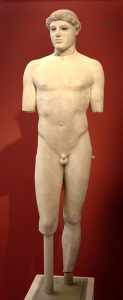Over time, humans have learnt more about the world around them and made scientific and technological breakthroughs, which in turn led to more complex lives, cultured societies, and art.
In the West, complex art began in Greece around 3,000 years ago. Sculpture was a central part of Greek art. It showed the beauty of the human body, and artists even represented gods and goddesses as humans. Greek sculptures show that Greeks studied the human body carefully, paid a lot of attention to details and did their best to represent human bodies in a realistic way.
A particularly famous example of Greek sculpture is called “Kritios Boy”. The  statue of a boy was carved from marble and created around 500 years BC. The sculptor created the statue in a realistic way that was true to how a person would stand in real life, with the weight shifted onto one leg and the other leg bent slightly. The head of the boy is also tilted in a way a real person would tilt their head. Most statues that pre-date Kritios Boy show people standing straight up, being straight-legged and looking straight ahead.
statue of a boy was carved from marble and created around 500 years BC. The sculptor created the statue in a realistic way that was true to how a person would stand in real life, with the weight shifted onto one leg and the other leg bent slightly. The head of the boy is also tilted in a way a real person would tilt their head. Most statues that pre-date Kritios Boy show people standing straight up, being straight-legged and looking straight ahead.
One of the reasons for Greeks being able to master arts was that Greek civilization had long periods of stability and economic prosperity. This allowed Greeks to develop their own style in all kinds of art, including architecture. The Greeks established many modern architectural ideas with their innovative designs, such as use of columns to distribute and support weight.
Among the most famous buildings epitomising Greek architecture is the Acropolis, which was built around 2,500 years ago. The Acropolis was a temple to the Greek goddess of wisdom. Its design is based on symmetry and mathematical precision.

